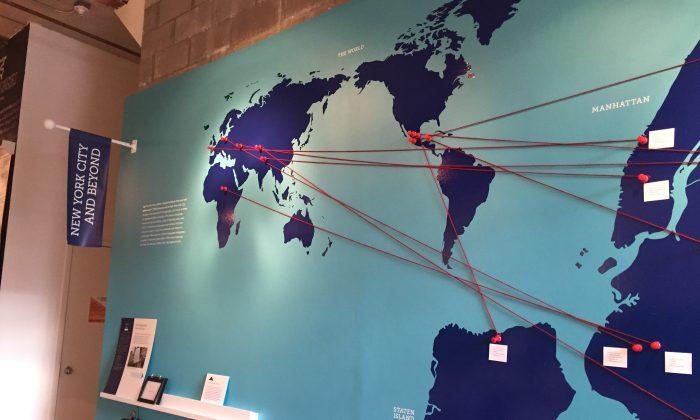NEW YORK—Did you know that in the foothills of southwestern China, there lives a group of 300,000 people whose written language looks like webdings? The Naxi have a funeral song that contains the following line: “The sons of bitterness are here; they wear their hats.” In written Naxi, it looks like nut-ladel-stickfigure-peacock-antelope-hat-arrow.
I’m first-generation Chinese-American, and I had no clue of such a language. My mother, who grew up in the south of China, had never heard of Naxi either. But she did know about a syllabic script, used exclusively by women, which grew out of a sex-segregated education system. This script, called nushu, is distinct from the logographic Chinese characters that we know; it is written phonetically like English or French. And it’s dead now.
When we think of languages dying out, we imagine tiny tribes in the rainforests of Brazil, whose mother tongues disappear when their last speakers pack off to the cities and start new, Portuguese-speaking lives.

But we don’t often think of language extinction as a potential problem in New York City, where on your way downtown on the F train you could hear Haitian Creole in one ear and Swedish in the other. Although linguistic diversity is a huge part of the New York identity, according to linguist Daniel Kaufman, it is under threat.
Babel Unraveling
Kaufman is a founder of the Endangered Language Alliance (ELA), an independent nonprofit based in New York City. The ELA estimates that 100 of the city’s 800 languages are endangered.
These include Wakhi, a Southeastern Iranian language spoken in Tajikistan, Pakistan, Afghanistan, China, and Brighton Beach, Brooklyn. There’s also Yiddish, where we get “oy vey,” “schmutz,” and “mensch.” Though Yiddish was the dominant international Jewish language, Hebrew and Arabic were made the official languages of Israel. Due to nationalism and secularism, Yiddish has been discouraged there in favor of Hebrew, though efforts are being made to preserve its legacy.
The most threatened languages in the world may have only 200–300 speakers. Other endangered ones have around 40,000 speakers.
“That’s a potentially stable population to sustain a language, but transmission patterns are changing rapidly due to the education system and government policies, so they are not really that stable,” Kaufman explained in a phone interview.
“It’s an issue among linguists that half the languages in the world might not be around by the end of the century,” he said. “They go out to document languages and do what they can to salvage languages, but until recently people have ignored big cities.” ELA fills that gap by focusing its research and advocacy activities on the languages spoken in New York City.
City Lore
ELA has partnered with Bowery Arts + Science and City Lore Gallery to launch an exhibit in celebration of lesser-known languages spoken in New York, and to get New Yorkers thinking about linguistic diversity.
One of City Lore’s goals as a cultural advocacy organization is to help New Yorkers “feel a sense of NYC community, not just in their neighborhoods, but as myriad cultures that come together,” said Abby Ronner, City Lore gallery director. “When you lose one [language], you lose a thread in the community, and soon the whole unravels.”

To give a taste of how City Lore works its grass-roots magic: Each year its small team (which includes an anthropologist, education director, folklorist, and ethnomusicologist) sends out a POEMobile into communities. The painted and winged truck is outfitted with a high-powered projector, and becomes the focal point for multilingual poetry readings and song festivals wherever it goes. City Lore’s other work includes teaching folk art in schools, and advocating preservation of culturally significant sites, such as a little-known meeting place for magicians inside the theater district’s Hotel Edison.
City Lore was founded in 1986 by Steve Zeitlin, a cultural commentator, author, and a former folklorist with the Smithsonian in Washington, D.C. Just last year, City Lore acquired a small gallery space on the Lower East Side.
In the Ear
The current exhibit immerses visitors in the sounds of rare languages. A video loops clips of native speakers—of Manchu, Mapuche, Nuer, Pintupi, and Sámi, among others. Photographs of 10 New York residents are paired with MP3s of them speaking their native tongues. One man tells a story in Gurung (also called Tamu Kyi), spoken in Nepal. He describes the dangerous sport of honey hunting, and though few will find the narrative intelligible, a careful listener will notice the lilting inflections that geographically place Gurung close to the Indian peninsula.
A small audio quiz tests New Yorkers’ abilities to place local accents. Bronx, Brooklyn, and Queens accents are pumped through a set of headphones while a flip book provides the answers. The exercise comes from Heather Quinlan’s 2013 documentary “If These Knishes Could Talk: The Story of the New York Accent.” In it, Quinlan explores the idea that accents tell the story of immigration, cross-influence, and the formation of New York character.
The most impressive element in the exhibit is a wallcovering, handwritten cento, a poem composed from lines by different authors—only this one takes its lines from endangered languages. Each line is translated into English, less to illuminate meaning than to hint at what can’t be translated—the cultural context at risk when a language is lost.
Exhibition Information
Mother Tongues: Endangered Languages in NYC and Beyond
Through April 16
City Lore
56 E. First St.
Free admission
212-529-1955
citylore.org






Friends Read Free